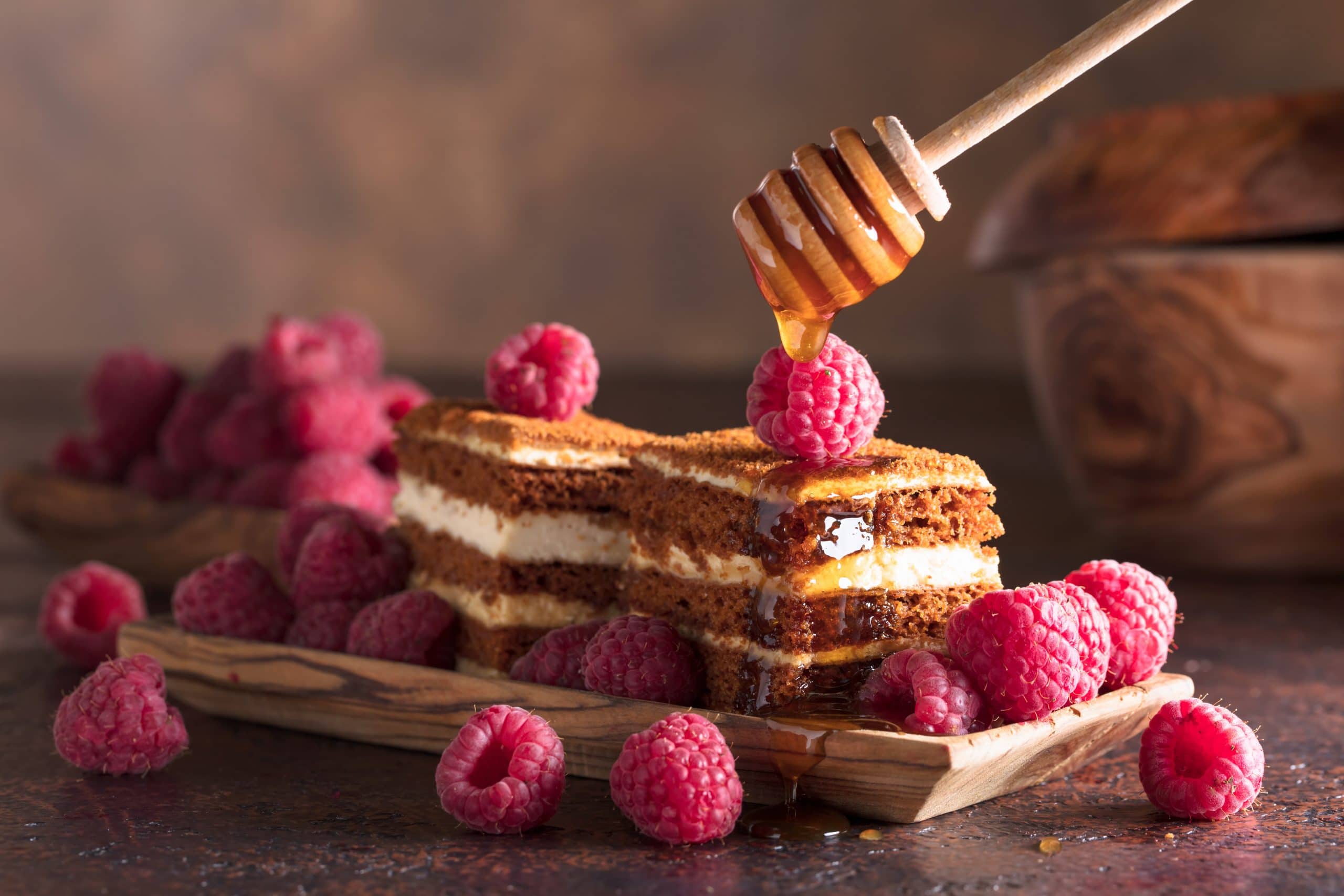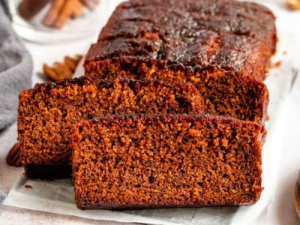Honey Cakes: Naturally Sweet Desserts
Honey cakes are the star of all honey desserts. As a testament to this, we see many nations with their own version of the cake. If you’re interested in honey balls, honeycomb, and nougat, read on as we’re about to look at the various cakes that use honey as a sweetener. You will also learn about the important role of bees and how to protect them.
Though honey is delicious when consumed raw, one major use of the product is baking. With a number of properties that allow it to work harmoniously with other ingredients, it sweetens and adds flavour to many honey treats. Today, we will explore cakes that feature this natural sweetener!
 Medovik is a layered honey cake (VikaLinka)
Medovik is a layered honey cake (VikaLinka)
Discovering Honey Cakes and Desserts
Medovik
We’ll start with Medovik, a Slovak honey cake. It’s no surprise to see Russians and Ukrainians prepare it similarly, with honey and sour cream as key ingredients. The cake sometimes features condensed milk, buttermilk, and custard as well. It consists of several thin layers stacked upon each other and refrigerated overnight. The chilling step allows the cake to absorb the cream and soften into a fluffy, dreamy dessert.
Bakers created this honey dessert for Empress Elizabeth Alexeievna in the 1800s. Rumoured to detest honey, a young chef made the honey layered cake without telling her the ingredients. The unfamiliar flavour of the Medovik impressed her, and the popularity of this dessert grew in the next century.
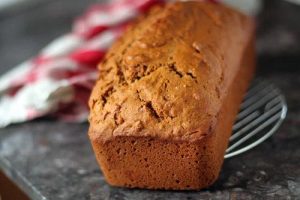 The French version, pain d’épices (David Lebovitz)
The French version, pain d’épices (David Lebovitz)
Pain d’épices, the French Specialty
The king of all honey-flavoured cakes is the pain d’épices, a spiced bread with honey. Yes, the nonnette is an individual gingerbread cake with honey and marmalade. But the pain d’épices has been around since the late 1600s, and it’s big enough to share. Its main ingredients are rye flour, honey, and spices. But not any honey: it needs to be dark buckwheat honey if possible. The pain d’épices was a specialty of Reims (France). As WWI wreaked havoc on this city, the centre of production moved to Dijon.
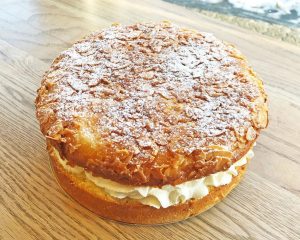 The bienenstich (Vancouver’s Breka Bakery)
The bienenstich (Vancouver’s Breka Bakery)
Bienenstich, a German Honey Dessert
Speaking of honey producers… they make us think of the bienenstich, or bee sting cake from Germany! Picture a sweet dough base filled with vanilla custard or cream, topped with caramelized slivers of almonds. This cake is even older than pain d’épices as it dates back to the 15th century. Rumours say that this cake was created by German bakers celebrating the ability to protect their village after throwing beehives at looters from another village.
Rosh Hashanah traditional cake (Rich and Delish)
Rosh Hashanah Cake
During the Jewish new year holiday, known as Rosh Hashanah, it is customary to eat a slice of apple dipped in honey to symbolically wish each other a sweet new year. To stay close to this tradition, Rosh Hashanah desserts are typically honey-flavoured. The most famous one is the honey cake. It is a honey-flavoured coffee cake, best enjoyed by pouring an extra amount of honey on top of it before serving! This honey dessert is widely available during the period of Rosh Hashanah (usually during September).
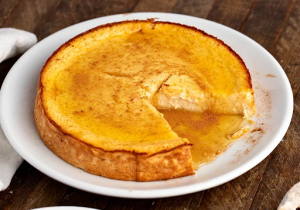 Melopita Sifnos, a Greek delicacy (My Greek Dish)
Melopita Sifnos, a Greek delicacy (My Greek Dish)
Melopita Sifnos
As if inspired by Biblical stories, this cake is a combination of milk and honey. It is a traditional honey and cheese cake created on the Greek isle of Sifnos. While the authentic recipe calls for a cheese named Anthotyro, finding it outside of Greece is difficult, and most recipes substitute it for ricotta cheese. The Melopita Sifnos cake has an outer crust, a creamy cheese filling, and the whole thing is covered in honey, giving it a rich, decadent, and sweet taste. Doesn’t it sound delicious?
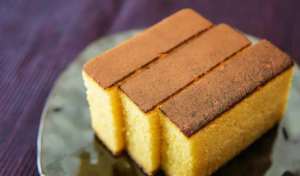
Traditional Japanese Castella sponge cake (Japan Centre)
Castella
Originally brought into Japan by Portuguese merchants in the 16th century, Castella (referring to the Iberian region of Castile) is now a Japanese tradition, considered a wagashi (traditional Japanese confectionery). To make it, the batter is poured into square moulds, baked and then cut into long rectangular slices. Serving it with tea or coffee or after a meal makes for a perfect experience.
Compared to the usual sponge cakes you surely know, Castella’s texture is more compact and less airy, but still lighter than butter cakes. So where is the honey? Honey is sometimes added to the batter so that the rich honey taste mixes in the dough’s flavour, or it is poured on top.

Bolo de mel (Wikipedia)
Bolo de mel
Bolo de mel is a Portuguese honey cake stemming from the Portuguese islands of Madeira in the Atlantic Ocean. With records of it dating back to the 15th century, this honey dessert is one of the oldest ones on the list. The dough is made with the usual flour, butter, and the original recipe called for molasses. But at some point in time, honey took its place. It is jam-packed with walnuts and almonds, as well as various spices like clove, cinnamon, black pepper, and anise.

Buccelato (Mangia Magna)
Buccelato, a Sicilian Christmas Cake
Buccelato is a Sicilian cake made with figs, dried fruit, raisins, dates, and nuts. Honey is used in the outer crust, either in the batter mix or poured on top. This sounds so rich and delicious. It is a common cake or sweet bread during Christmas time. Despite the cold, despite the early sunsets, winter is worth the wait just to enjoy one of these exquisite cakes!
All of these desserts and cakes owe their signature flavour to the sweet and aromatic taste of honey. And as we all know, honey comes from those little black and yellow-striped fellows called bees, involving a complex and fascinating process of collecting nectar from flowers, storing it in honeycombs, and fanning it with their wings to dehydrate it, thus producing honey. Now, aside from the honey-making process, let’s take a look at bees themselves and discuss how vital they are to nature.
Why Do Bees Matter So Much to the Environment?
Without bees, there would be no honey, and therefore no honey cakes. But bees don’t only give us delicious honey, they are vital actors in the ecosystem.
-
Food Security and Biodiversity:
By pollinating flowers, they contribute to thriving vegetation, which in turn benefits other insects, plants, and animals. They provide food security for a great number of other species and help maintain biodiversity. Crops produce better yields if insects pollinate them. And among the animal kingdom, bees are the main pollinators of crops.
-
Production of Honey: Honey isn’t only a good-tasting food. For thousands of years, across many cultures, people have used honey for its nutritional and medicinal benefits. In fact, honey has antioxidant, antimicrobial, anti-inflammatory, and anticancer properties.
-
Creation of Beeswax:
Alongside honey, beeswax has lots of other great properties and uses. Due to its waxy quality, it is sometimes used as a material for producing certain types of goods. It also has various health benefits and can be used in skin care products and ointments.
It isn’t surprising that all sacred texts across the world mention bees. They are essential to the world’s functioning and good health. Due to extensive use of pesticides, diseases, climate change and loss of habitat due to industrialization, bee populations are declining worldwide. The impact of a world without bees extends beyond just the loss of honey production. It would cause significant shortages of fruits, vegetables and nuts, reducing biodiversity and threatening wildlife in general. In financial terms, the losses would be catastrophic. Considering all of this, the importance of bees cannot be overlooked.
Now, what can you do to help protect bees? There are a few everyday gestures that anyone can integrate in their routine, and that can have a great positive impact on the life of bees.
-
According to WWF: Plant a range of flowers in your garden so bees have access to nectar from March to October. You can use the winter season to plan a garden full of nectar-rich plants that bees can forage come spring. Bees love traditional cottage garden flowers and native wildflowers, like primrose, buddleia, and marigolds.
-
As Honey Flow, an Australian beekeeper, explains, let your garden get a little messy, and be “garden lazy” most people love a neat lawn and weed-free garden beds, however, traditional lawns are pollinator deserts and most weeds (e.g. dandelions and clover) are a great source of forage for the bees. Let your veggie and herb plants flower and let the dandelions bloom.
-
Buy organic food and goods as much as possible that do not require pesticides. This could range from fruits to cotton clothes. By reducing the demand for goods produced with pesticides that harm bees, you not only promote crops that bees can pollinate, but you also consume healthier food.
-
Of course, you can also support organizations that work hard to protect bees and other pollinators. Bee City is a Canadian program aimed at inspiring cities to adopt bee-friendly initiatives. Wildlife Preservation Canada collaborates with many international partners to develop pollinator conservation projects, including bee farms and biodiversity monitoring. Save the Bees is an American organization that funds research on bees and supports environmental preservation efforts.
Each one of these honey desserts sounds incredible. Even if they all contain honey, their recipes are varied and reflect the diversity of all of their respective cultures. We hope that the next time you see a bee, you’ll enjoy watching it fly from flower to flower to help the world thrive. To find the best honey cakes, let us help you search locally for honey-based products near you.
